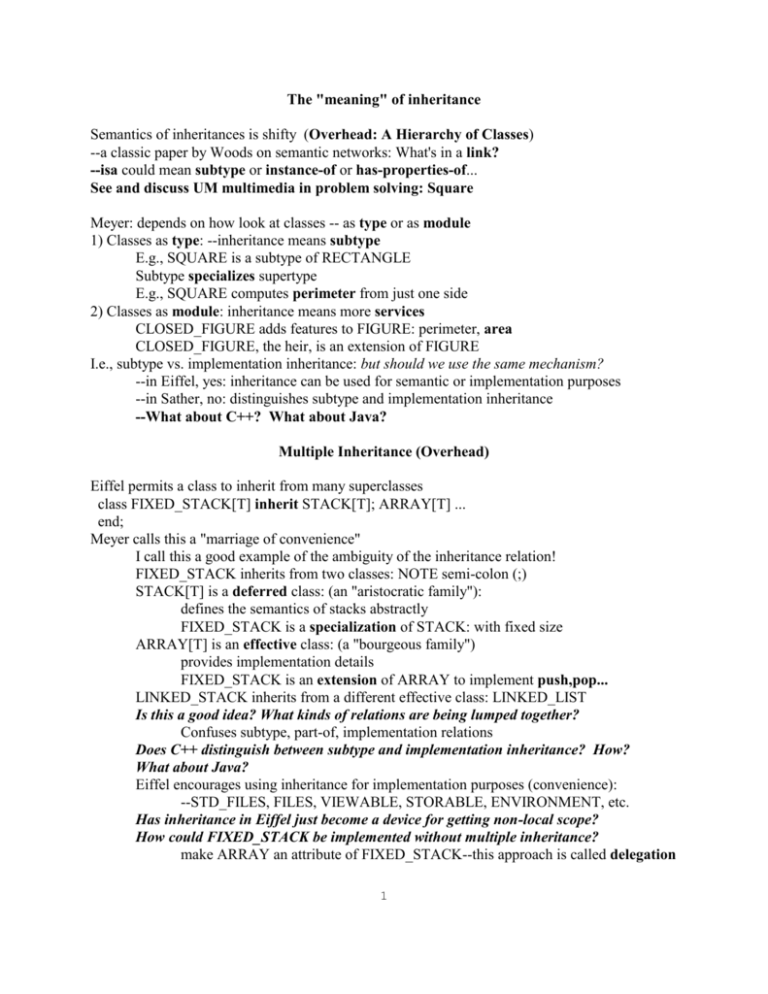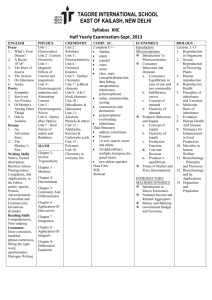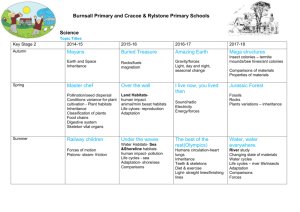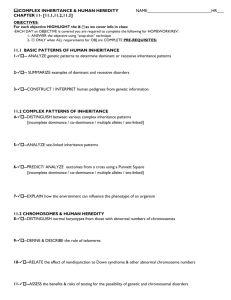Lecture on issues with inheritance
advertisement

The "meaning" of inheritance
Semantics of inheritances is shifty (Overhead: A Hierarchy of Classes)
--a classic paper by Woods on semantic networks: What's in a link?
--isa could mean subtype or instance-of or has-properties-of...
See and discuss UM multimedia in problem solving: Square
Meyer: depends on how look at classes -- as type or as module
1) Classes as type: --inheritance means subtype
E.g., SQUARE is a subtype of RECTANGLE
Subtype specializes supertype
E.g., SQUARE computes perimeter from just one side
2) Classes as module: inheritance means more services
CLOSED_FIGURE adds features to FIGURE: perimeter, area
CLOSED_FIGURE, the heir, is an extension of FIGURE
I.e., subtype vs. implementation inheritance: but should we use the same mechanism?
--in Eiffel, yes: inheritance can be used for semantic or implementation purposes
--in Sather, no: distinguishes subtype and implementation inheritance
--What about C++? What about Java?
Multiple Inheritance (Overhead)
Eiffel permits a class to inherit from many superclasses
class FIXED_STACK[T] inherit STACK[T]; ARRAY[T] ...
end;
Meyer calls this a "marriage of convenience"
I call this a good example of the ambiguity of the inheritance relation!
FIXED_STACK inherits from two classes: NOTE semi-colon (;)
STACK[T] is a deferred class: (an "aristocratic family"):
defines the semantics of stacks abstractly
FIXED_STACK is a specialization of STACK: with fixed size
ARRAY[T] is an effective class: (a "bourgeous family")
provides implementation details
FIXED_STACK is an extension of ARRAY to implement push,pop...
LINKED_STACK inherits from a different effective class: LINKED_LIST
Is this a good idea? What kinds of relations are being lumped together?
Confuses subtype, part-of, implementation relations
Does C++ distinguish between subtype and implementation inheritance? How?
What about Java?
Eiffel encourages using inheritance for implementation purposes (convenience):
--STD_FILES, FILES, VIEWABLE, STORABLE, ENVIRONMENT, etc.
Has inheritance in Eiffel just become a device for getting non-local scope?
How could FIXED_STACK be implemented without multiple inheritance?
make ARRAY an attribute of FIXED_STACK--this approach is called delegation
1
A potential problem--consider the following code fragment:
s:FIXED_STACK[CHARACTER];
!!s.make; --FIXED_STACK's make creates an ARRAY of some default size
s.put('A',3); putchar(s @ 3); --using ARRAY routines from FIXED_STACK
What's the problem here? [Violation of semantics of STACK (see ADT axioms)]
Information hiding problem: how do we hide ARRAY access from clients of STACKs?
Eiffel 3 fixes this bug--by allowing heirs to restrict exports from parents:
class FIXED_STACK[T] inherit
STACK[T];
ARRAY[T]
features {NONE} --effectively prevents clients from accessing features of ARRAY
Thus, FIXED_STACK inherits its interface from STACK, its implmentation from ARRAY
interface or subtype inheritance is public; implementation inheritance is private or secret
What do you think of this approach--as opposed to composition and delegation?
When might multiple inheritance be a good idea just in terms of subtype relations?
Here’s a possibility: a DOG can be both an ANIMAL (eats) and a PET (lives-in-house)
Single inheritance forms a tree
views reality as hierarchical--as in the military!
Multiple inheritance permits a more complicated graph: a directed acyclic graph or DAG
views reality as hetararchical
Designing WINDOWs with multiple inheritance
(overhead: another application of renaming)
Meyer gives another (in my opinion, better) example of multiple inheritance: WINDOWs
Windows are graphical objects, typically rectangular (height, width)
Windows are also hierarchical--open subwindow, return to superwindow
hierarchy may be implemented as a TREE
By all means, reuse both classes!
class WINDOW
inherit RECTANGLE --inherit graphical features
TREE
--inherit hierarchial
2
Rename
Back to our marriage of convenience:
class FIXED_STACK[T]
creation make,makeToSize
inherit STACK[T]
redefine change_top;
ARRAY[T]
rename make as array_make, size as max_size;
feature
default_size: INTEGER is 100; --default_size is a constant
make is
do array_make(1,default_size) --calls ARRAY's creation routine, make(MIN,MAX)
end;
makeToSize(n:INTEGER)
do array_make(1,n)
end;
...
end;
--redefine and rename clauses may appear after each parent
--redefine lets heir provide another implementation for a feature
--FIXED_STACK redefines STACK's version of change_top
--rename lets heir give parent's feature a new name
--Rename has three purposes:
1) To let heir use parent's Create routine (remember Create rule)
--FIXED_STACK invokes ARRAY's create as array_Create
2) To avoid name clashes:
--lets FIXED_STACK access both array_size and its own size
3) To provide better labels for heir
--e.g., class WINDOW
inherit RECTANGLE;
TREE rename insert_node as add_subwindow;
change_child as change_subwindow; etc.
--Why is this a good idea?
--TREE's routine names are misleading in implementation of WINDOW
--How to do this in C++ or Java?
3
Multiple inheritance in C++
Single inheritance restricts class derivation to a hierarchy (tree)
Smalltalk and Objective-C only support single inheritance (though there are work-arounds)
But sometimes the world doesn't map into a neat heiarchy
e.g., lions are carnivores, and lions are zoo animals
But are all carnivores zoo animals? Or are all zoo animals carnivores?
C++ (starting with 2.0) introduces the possibility of deriving from more than one base class
class
class
class
class
ZooAnimal {//...};
Carnivore {//...};
Herbivore {//...};
Lion: public ZooAnimal, protected Carnivore {};
--derivation can specify a list of base classes
--an instance of Lion inherits features from both ZooAnimal and Carnivore
Very nice, but multiple inheritance can also complicate things! Any idea why?
Name collisions--what if two parent classes have a member (feature) with the same name?
(Overhead: Repeated Inheritance)
Let's talk about how C++ handles this: suppose two different base classes use the same name:
e.g., suppose both ZooAnimal & Carnivore include a member function, locate()
Using the name is ambiguous and results in a compile time error
Disambiguate by using the class scope operator:
Lion::locate() //Encapsulate & invokes both members
{ ZooAnimal::locate(); Carnivore::locate(); }
Suppose a class can derive from the same base class in multiple ways?
class Panda: public Bear,public Bear; //illegal--unresolvable ambiguity!
But zoologlists debate about whether Panda properly belongs to Bear or Racoon families:
class Panda: public Bear,public Racoon; //both derive from ZooAnimal
ZooAnimal
/
\
Bear
Racoon
/
\
Panda
Panda
Question: does class Panda get one representation of base class ZooAnimal, or two?
By default, C++ generates two ZooAnimal base class parts for a Panda, e.g.:
--------------Here's how a Panda gets built:
ZooAnimal part
runs ZooAnimal() constructor for Bear()
-------Bear Part
runs Bear() constructor
--------------ZooAnimal part
runs ZooAnimal() constructor for Racoon()
-------Racoon part
runs Racoon() constructor
--------------Panda part
runs Panda() constructor--derived class is last
--------------4
Suppose ZooAnimal has a member, e.g., locate()--how do we invoke it from Panda?
Once more, use class scope operator, e.g.:
Panda::locate()
{ return ( (isA() == BEAR)) //isA is home-brewed RTTI
? Bear::locate : Racoon::locate() ) ;
} //Intermediate base class disambiguates which ZooAnimal member to use
Suppose we want don't want duplicate, ambiguous base classes?
Then declare virtual base classes:
class Bear: public virtual ZooAnimal {//...};
class Racoon: virtual public ZooAnimal {//...};
class Panda: public Bear,private Racoon; //both derive from ZooAnimal
Panda p; p.locate(); //p has just one ZooAnimal; invokes unique ZooAnimal::locate()
Note: shared virtual base class uses most accessible level of protection
5
Covariance vs. Contravariance (from the Sather FAQ)
Consider the following situation: we have two classes PARENT and CHILD.
CHILD inherits from PARENT, and redefines PARENT's feature 'foo'.
class PARENT
feature
foo (arg: A) is ...
end; -- PARENT
class CHILD
inherit PARENT redefine foo
feature
foo (arg: B) is …
end; -- CHILD
The question is: what restrictions are placed on the type of argument to 'foo', that is 'A' and 'B'?
(If they are the same, there is no problem.)
Here are two possibilities:
(1) B must be a child of A (the covariant rule - so named because the inheritance “varies”
for both classes in the same direction: in the child class the types of arguments in redefined
routines are children of types in the parent's routine, so)
(2) B must be a parent of A (the contravariant rule) – inheritance “varies” in opposite
directions for class hierarchy vs. argument types.
Which rule do you think is better? Eiffel uses the covariant rule.
At first, the contravariant rule seems theoretically appealing.
Recall that polymorphism means that an attribute can hold not only objects of its declared type,
but also of any descendant (child) type.
Dynamic binding means that a feature call on an attribute will trigger the corresponding feature call
for the actual type of the object, which may be a descendant of the declared type of the attribute.
With contravariance, we can assign an object of descendant type to an attribute,
and all feature calls will still work because the descendant can cope with feature arguments
at least as general as those of the ancestor.
In fact, the descendant object is in every way also a fully-valid instance of the ancestor object:
we are using inheritance to implement subtyping.
Here's an example which suggests a covariant solution.
Herbivores eat plants. Cows are herbivores. Grass is a plant. Cows eat grass but not other plants.
class HERBIVORE
class PLANT
feature
eat(food: PLANT) is ...
diet: LIST[PLANT]
class COW
class GRASS
inherit HERBIVORE
inherit PLANT
redefine eat
end
6
feature eat(food: GRASS) is ...
The Eiffel compiler stops us from putting a COW object into a HERBIVORE attribute
and trying to feed it a PLANT (rather than GRASS).
In programming real-world applications we may need to specialize related classes jointly.
Here is another example, where PLOT_3D inherits from PLOT,
and DATA_SAMPLE_3D inherits from DATA_SAMPLE.
class PLOT
feature
add(arg: DATA_SAMPLE) is ...
class PLOT_3D
inherit
PLOT redefine add
feature
add(arg: DATA_SAMPLE_3D) is ...
This requires the covariant rule, and works well in Eiffel.
The compiler will not let us put a PLOT_3D object into a PLOT attribute
and try to add a DATA_SAMPLE to it.
To summarise: Real-world problems often lend themselves to covariant solutions. Eiffel handles
these well. Incorrect programs in the presence of covariant argument redefinition can cause runtime type errors unless the compiler catches these.
Sather uses the contravariant rule,
but uses separate mechanisms for subtyping and code reuse
and only allows dynamic binding on true subtypes.
This seems to make contravariance work well, but it can force the Sather programmer
to use concrete types when modeling covariant problems.
Concrete types cannot be further subtyped in Sather,
so this can reduce the potential for re-use
(in Eiffel, any type can be further subtyped,
but the compiler must check that it is used validly).
7






